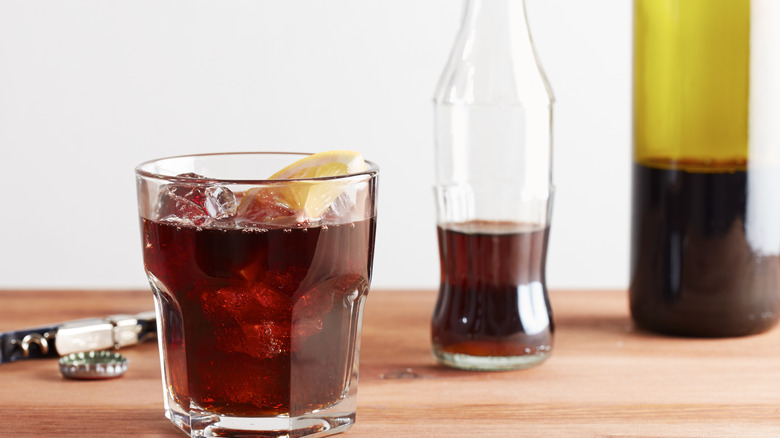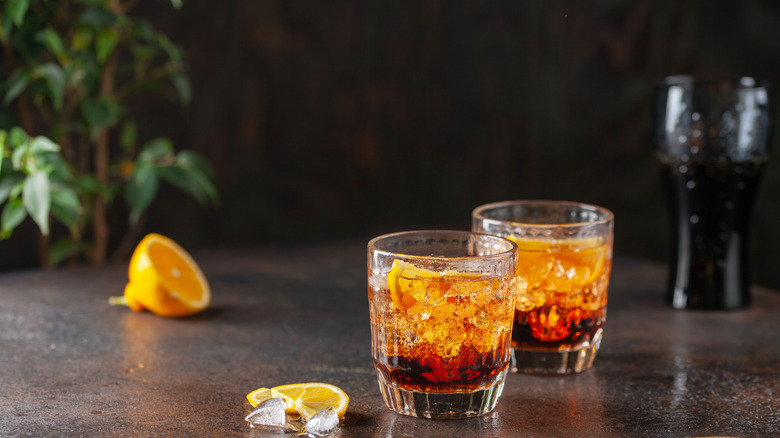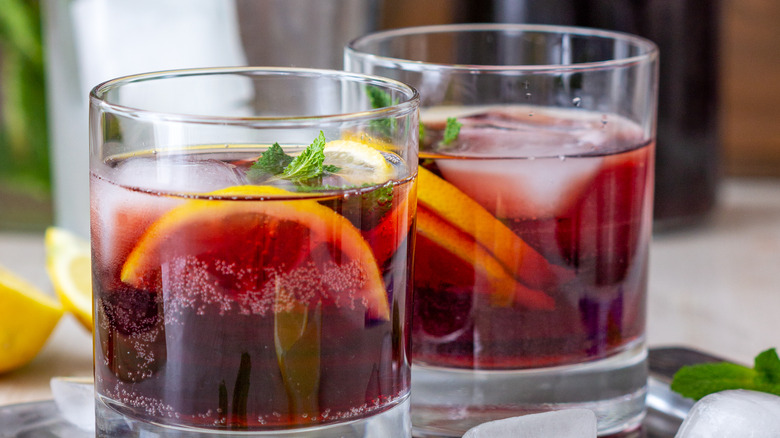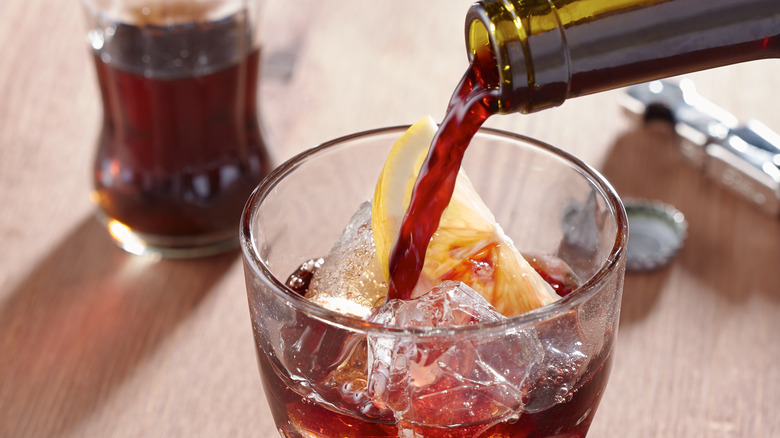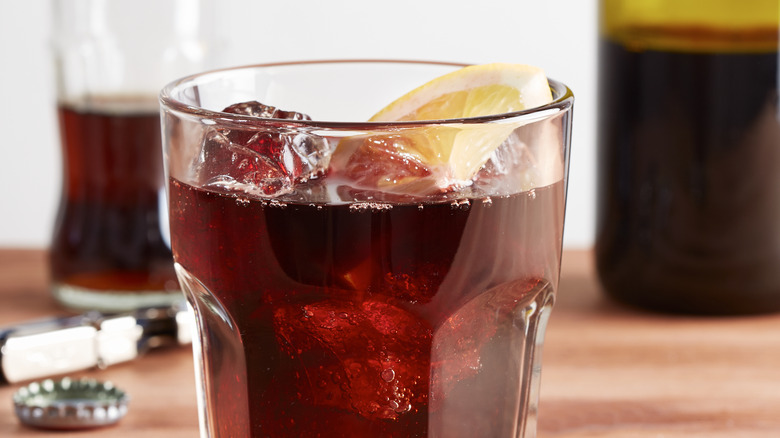The Untold Truth Of The Kalimotxo Cocktail
The Kalimotxo cocktail may not immediately ring any bells, but if you love to travel, you may have seen the drink on menus around the world. In Romania, locals refer to the beverage as motorină, Chileans call it jote, and the cocktail goes by vadász or vörösboros vóla in Hungary, per Hella Basque. This concoction is immensely simple to make but much more than the sum of its parts. Belied by its alluring name, the Kalimotxo contains only two ingredients that you probably already have in your kitchen — cola and red wine (via The New York Times).
While this beverage looks simple on paper, the flavors packed into each glass can easily win you over and make you realize why people the world over have found something to love about the unexpected marriage of wine and cola. You couldn't ask for a more straightforward cocktail but despite its basic nature, the Kalimotxo hides a ton of unexpected secrets right below its surface.
The Kalimotxo's contested history
The Kalimotxo, which hails from the Basque region of Spain, came to prominence in the 1970s and was given its current name when festival-goers haphazardly added some cola to a bottle of less-than-ideal red wine, according to Esquire. The drink took off from there, spreading throughout the country, before taking hold of the world. The Huffington Post notes that prior to receiving its now-official name, bar patrons could find the cocktail on menus with names like Rioja Libre or Cuba Libre del pobre prior to 1972. The Kalimotxo moniker was invented by a group of friends at a 1972 Puerto Viejo festival (via Hella Basque). These party-goers found that the red wine served at the event had an unpleasant taste, but could be improved when mixed with cola. They needed a name for this concoction and drew inspiration from two mutual acquaintances, named Kalimero and Motxo. The Kalimotxo was born when the partiers put the acquaintances' names together, and the rest is history.
Instituto Hemingway takes the lore of the cocktail back even further, noting that the combination of cola and red wine originated in the 1920s. The drink came to public knowledge when a Coca-Cola factory opened in Spain in 1953, and bars started offering Rioja Libres or Cuba Libre del pobres. Some versions of the cocktail's origin also claim the namesakes of the concoction, Kalimero and Motxo, were the same person and Moxto's harsh-sounding Basque name was just the local pronunciation of Kalimero. Despite its contested history, no one can argue that the beverage won party-goers over.
The best way to drink the Kalimotxo
With a drink this simple, many have adapted the way they enjoy Kalimotxos to their preference, like adding a touch of citrus to brighten up the flavor, per The Delicious Spoon. At its core, the Kalimotxo is a simple, delicious blend of red wine and Coke that doesn't need a ton of frills to hit the spot. While the flavors might sound disparate, you'll be stunned at how harmoniously the balance of sweetness, carbonation, acidity, and caffeine blend together for a pleasurable drinking experience. Many have come to love the Kalimotxo and associate it as an easy-sipping summer cocktail thanks to its cool temperature and low alcohol content. Some also attest that the best way to enjoy a Kalimotxo involves drinking the beverage out of a half-empty Coke bottle or red wine bottle, according to The Huffington Post.
Don't feel like you have to down a Kalimotxo out of a red wine bottle either. Fans have also mixed up a version of this drink with pineapple juice instead of Coke and white wine in wine bottles to create a new twist on the cocktail called the Tinto de Verano and kept the party going all night long.
Kalimotxo's new, delicious flavors
Nowadays, you can order a ton of stellar Kalimotxo variations at bars and restaurants worldwide. Imbibe Magazine has a signature recipe for the cocktail that contains red wine, Mexican Coca-Cola, amaro, bitters, and a lime wheel. Vinepair spoke with various bartenders who sang Kalimotxo praises, and one particular mixologist creates a frozen version of the beverage that uses Coca-Cola syrup. Another special Kalimotxo from Pittsburgh's DiAnoia's Eaterycalls for Fernet, vanilla, coffee, creme de cacao, and sparkling red wine to add acidity and carbonation. Bloomberg even references a Txerry Kalimotxo, which is bolstered with the flavor of sweet cherries.
If you decide to make the concoction at home, don't think for a second that you have to settle for a classic, high-fructose cola either. The New York Times states that the drink is even better made with a cane sugar-based Coca-Cola instead of corn syrup. The sky's the limit when it comes to experimenting with this beverage, and with any luck, you might discover the next hot twist on this iconic cocktail.
Effects of the Kalimotxo
The Kalimotxo is a bit of a mixed bag when it comes to nutrition. Anyone who has a sensitivity to alcohol or acid reflux issues may want to avoid drinking too many of these cocktails in excess (via Healthline). While red wine has its downsides, some professionals now acknowledge the ingredient as being an advantageous libation to consume in moderation, as it may reduce the risk of heart disease and increase good cholesterol, per The Mayo Clinic.
On the flip side, downing too much cola can have an immediate negative impact on the body. According to Medical News Today, anyone who indulges in this drink on a daily basis saw an increase in tooth decay, weight gain, worsening organ health, and more. Generally, the alcohol content and sugar of a single glass of Kalimotxo shouldn't hurt, so enjoying a cocktail here and there shouldn't prove troublesome and guarantees to keep the good times rolling.
